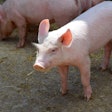
As China’s pig herd continues to be depleted by African swine fever (ASF), pork prices are rising and the country is becoming increasingly dependent on imports to supply its demand for pork.
Since the outbreak of ASF in the country in August 2018, more than 1 million pigs have died from the disease or been culled to prevent further spread. In April, the Ministry of Agriculture and Rural Affairs said China’s sow population had fallen 21% from the previous year, but some experts think the actual number is higher than reported. ASF is highly contagious in pigs and almost 100% fatal, but poses no risk to humans.
Pork is a staple in Chinese diets and the country makes up about half of the world’s pork consumption. Data released this week shows that the consumer price index in China rose 2.7% from a year ago. Food prices were up 7.7% in May compared with the previous year, and pork prices were up 18.2% in the same period. China’s agriculture ministry said in April that Chinese pork prices were expected to jump more than 70% from the previous year in the second half.
One economist quoted in a CNBC report said that, “if the disease spreads and increases in severity, it would probably make a notable contribution to inflation in parts of Asia … and Eastern Europe.”
James Swanston, assistant economist at Capital Economics, told CNBC that Taiwan, Cambodia, Vietnam, Russia, Poland and Romania could see these effects, while consumer prices in other emerging markets could rise by about 0.3% if pork inflation were to rise to 15%.
More imports, domestic production
With China’s pork supply falling, the country must rely more heavily on imports from other countries, including the U.S., but the U.S.-China trade dispute is complicating the situation.
In July 2018, before China’s ASF outbreak began, China raised tariffs on U.S. pork to 62%, and China’s imports of U.S. pork fell by 30% in 2018. However, the U.S. Department of Agriculture estimates China’s pork imports will rise 40% in 2019. According to the Nikkei Asian Review, “China has no choice but to rely on American imports” while it seeks out other suppliers.
Canada had already increased its pork exports to China by 80% in March compared with the previous year, and Argentina and the EU are also expected to increase exports to China.
Several pork producers, including Rusagro, CP Group, Muyuan Foodstuff and WH Group, are planning to ramp up pork production in China to help meet demand.
Demand for soybeans down, poultry up
Meanwhile, as Chinese consumers begin to look to alternative protein sources such as poultry and beef, demand for soybeans could also see a drop.
“Looking ahead, China should start to increase its poultry consumption. … Chicken feed requires less protein, so if China is eating more poultry, demand for soybeans and corn could wane,” Capital Economics said in March.
As a result of the ongoing trade dispute between the two countries, China’s imports of U.S. soybeans in 2018 were the lowest in a decade, and data from February showed that China’s imports of U.S. soybeans were at their lowest monthly level in four years.
View our continuing coverage of the African swine fever outbreak.

















